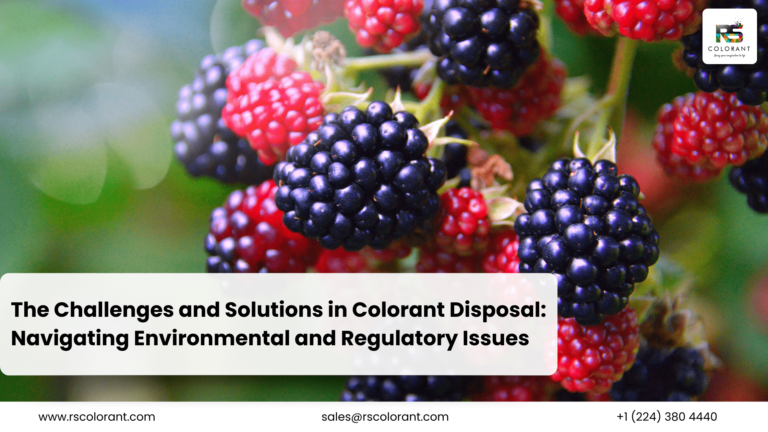Colorants in the Textile Industry – Introduction
Colorants are the unsung heroes of the textile industry, transforming plain fabrics into vibrant works of art. But what exactly are colorants, and why are they so important? Let’s dive into the colorful world of textiles and uncover the role these substances play.
History of Colorants in Textiles
Early Natural Dyes
Long before the advent of synthetic dyes, ancient civilizations relied on natural colorants derived from plants, minerals, and even insects. Think of the rich purple extracted from the Mediterranean mollusk or the vivid red from the cochineal insect in South America. These natural dyes were not just colors; they were symbols of status and wealth.
Transition to Synthetic Dyes
The mid-19th century marked a significant shift with the accidental discovery of the first synthetic dye, mauveine, by William Henry Perkin. This discovery paved the way for a plethora of synthetic dyes, revolutionizing the textile industry by making vibrant colors more accessible and affordable.
Types of Colorants Used in Textiles
Natural Colorants
Derived from natural sources, these colorants are often favored for their eco-friendly properties. They include plant-based dyes like indigo and madder, as well as mineral and animal-derived dyes.
Synthetic Colorants
These are man-made dyes created through chemical processes. They offer a broader range of colors, greater color fastness, and are more cost-effective compared to natural dyes.
Pigments vs. Dyes
While dyes dissolve in water and bond with the fabric, pigments are insoluble particles that coat the surface. Both have distinct applications and benefits in the textile industry.
Natural Colorants
Sources of Natural Colorants
Natural colorants come from a variety of sources including plants (like indigo and saffron), minerals (like ochre and malachite), and animals (like cochineal and Tyrian purple).
Advantages of Natural Colorants
They are biodegradable, non-toxic, and often have antimicrobial properties. Plus, they provide a unique, earthy aesthetic that synthetic dyes can’t quite replicate.
Limitations and Challenges
Natural dyes often lack the vibrancy and colorfastness of their synthetic counterparts. They can also be more expensive and less consistent in hue.
Synthetic Colorants
Development of Synthetic Dyes
Since Perkin’s mauveine, synthetic dyes have evolved tremendously. Today, we have a vast array of synthetic dyes tailored for different fibers and purposes.
Types of Synthetic Dyes
These include acid dyes, basic dyes, direct dyes, disperse dyes, reactive dyes, and vat dyes, each with unique properties and applications.
Benefits of Synthetic Dyes
Synthetic dyes are known for their vibrant colors, consistency, and durability. They are also more economical and can be produced in large quantities.
Environmental Impact
However, synthetic dyes pose significant environmental concerns. They can cause water pollution and are often made from non-renewable resources.
Application Methods of Colorants
Direct Dyeing
This is the simplest method where dyes are directly applied to the fabric.
Yarn Dyeing
In this method, yarns are dyed before they are woven into fabrics, allowing for multi-colored patterns.
Fabric Dyeing
Fabrics are dyed after they are woven. This method is commonly used for solid-colored textiles.
Garment Dyeing
Dyeing is done on fully constructed garments, providing flexibility for fashion trends.
Color Fastness in Textiles
Definition and Importance
Color fastness refers to the resistance of a fabric’s color to fading or running. It is a critical quality measure in textiles.
Factors Affecting Color Fastness
Factors include the type of dye, the dyeing process, and the conditions of use, such as exposure to light, washing, and perspiration.
Testing Methods
Common methods include the ISO and AATCC standards, which assess various aspects like light fastness, wash fastness, and rub fastness.
Innovations in Textile Colorants
Eco-Friendly Dyes
New eco-friendly dyes are being developed to reduce environmental impact, such as dyes that use less water and energy.
Smart Textiles
Innovative colorants are used in smart textiles that can change color in response to environmental stimuli like temperature and light.
Digital Printing
Digital printing allows for precise application of colorants, enabling intricate designs and reducing waste.
Sustainability in Textile Dyeing
Environmental Concerns
Traditional dyeing processes consume large amounts of water and release harmful chemicals into the environment.
Sustainable Practices
Practices like waterless dyeing, use of natural dyes, and recycling of dye effluents are becoming more common.
Industry Trends
The industry is moving towards more sustainable practices, driven by consumer demand and regulatory pressures.
Regulations and Standards
Safety Standards
Regulations ensure that colorants are safe for consumers and workers, reducing the risk of exposure to harmful chemicals.
Environmental Regulations
These aim to minimize the environmental impact of dyeing processes by controlling emissions and waste.
Industry Certifications
Certifications like OEKO-TEX and GOTS ensure that textiles meet high environmental and social standards.
Case Studies
Historical Case Studies
Examining historical use of natural dyes, such as indigo in ancient India and Tyrian purple in the Roman Empire, provides insights into traditional practices.
Modern Case Studies
Companies like Patagonia and Levi’s are leading the way in sustainable dyeing practices, showcasing modern innovations.
Challenges and Future Directions
Current Challenges
Challenges include finding cost-effective, eco-friendly dyeing methods and dealing with the environmental impact of synthetic dyes.
Future Innovations
Future directions may involve biotechnology, such as genetically engineered microorganisms that produce natural dyes, and advances in dyeing technologies.
Conclusion
Colorants are vital to the textile industry, offering a palette of possibilities that enhance the beauty and functionality of fabrics. As we move towards a more sustainable future, innovations in dyeing processes and materials will continue to shape the industry.
FAQs
What are colorants in textiles?
Colorants are substances used to impart color to textiles, including both natural and synthetic dyes and pigments.
How are natural and synthetic colorants different?
Natural colorants are derived from plants, minerals, and animals, while synthetic colorants are man-made through chemical processes. Synthetic colorants generally offer more vibrant and consistent colors.
What is color fastness?
Color fastness refers to a fabric’s resistance to fading or running, ensuring that the color remains vibrant and durable over time.
Are there eco-friendly textile colorants?
Yes, eco-friendly textile colorants include natural dyes and new synthetic dyes designed to reduce environmental impact by using less water and energy.
What does the future hold for textile dyeing?
The future of textile dyeing lies in sustainable practices, innovations in eco-friendly dyes, and advanced technologies like digital printing and smart textiles.




